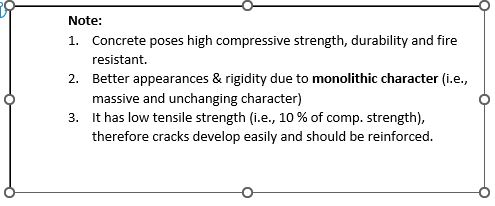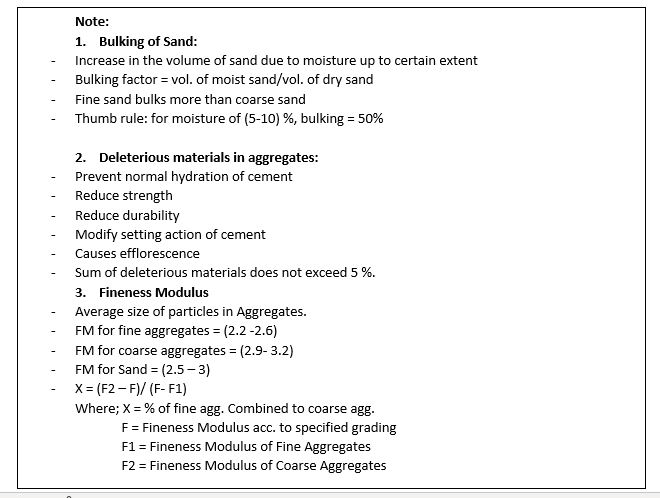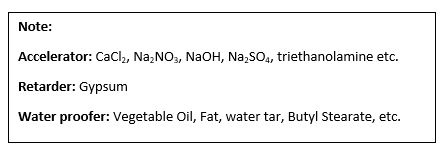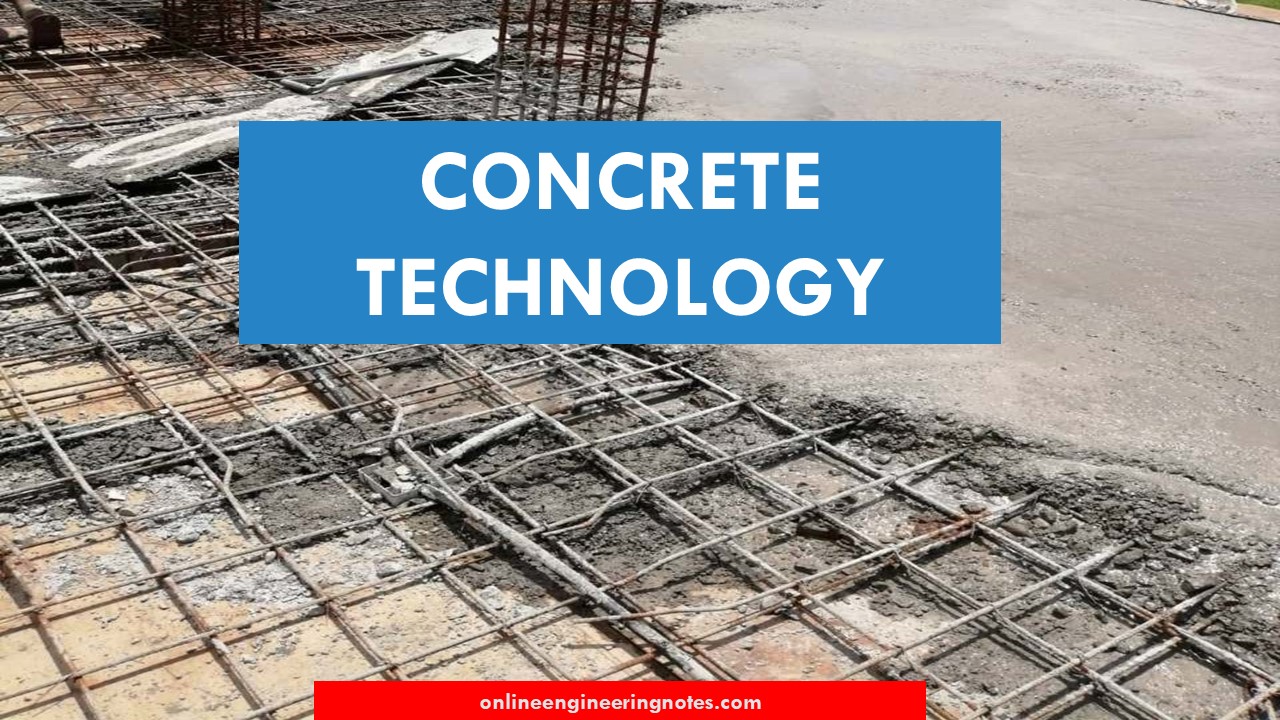Concrete
- Artificially built-up Stone with Cement, Water, Aggregates with or without Admixtures
Constituents of Concrete:
Aggregates = (60-70) %
Water = (7- 15) %
Cement = (14-21) %
Air = (0 – 3) %
Properties of Concrete:
- Air Content
- Fluidity
- Strength
- Setting Time
- Durability

Types of Concrete:
- Based on Binding Materials
- Cement Concrete
- Lime Concrete
- Based on Design
- Plain Concrete (no reinf.)
- Reinforced Concrete
- Prestressed Concrete (High Compressive Stress are artificially induced before use)
- Based on Density
- Light Weight Concrete (18 KN/M3) (i.e., by using pumice from volcanoes or bloated aggregates)
- Normal Weight Concrete (24 KN/M3)
- Heavy Weight Concrete (32 KN/M3)
Boated Aggregates?
- Slightly Salted and lightly smoked
Cement
Composition of Cement Clinker:
Tricalcium Silicate (C3S) – 40%
- Cement hydrates more rapidly
- Generates more heat of hydration
- Develops high early strength
- Possesses less resistance to Sulphur Attack
Dicalcium Silicate (C2S) – 32 %
- Cement hydrates slowly
- Generates less heat of hydration
- Provides good ultimate strength
- More resistance to sulphate attack
Tricalcium Aluminate (C3A) – 10.5 %
- Reacts fast with water
- Generates a large amount of heat of hydration when reacts with water.
- Causes initial setting of cement
- First compound which reacts with water

Tetra Calcium Alumino Ferrite (C4AF) – 9 %
- Poor cementing value
- Reacts slowly with water
- Generates small heat of hydration
Types of Cement:
Ordinary Portland Cement (OPC)
- Common type of cement
- Resistance to dry shrinkage and cracking
- Less resistance to chemical attack
- Shouldn’t be used for construction work exposed to sulphate
Rapid hardening Portland Cement (RHPC)
- High early strength cement
- Lighter than OPC
- Shouldn’t be used for massive concrete structures
Low Heat Portland Cement (LHPC)
- Low percentage of tri-calcium silicate
- High percentage of di-calcium silicate
- Hydrates slowly
- Less lime than OPC
- Possesses less compressive strength
- Widely used in retaining walls
- Shouldn’t be used for thin concrete structures
Sulphate Resisting Portland Cement (SRPC)
- Percentage of C3A kept below 5%
- Resisting power against sulphates
- Used for structures subjected to severe alkaline conditions such as canal linings, culverts, etc.
High Alumina Cement (HAC)
- 35% of Alumina
- Sets slowly
- Obtained higher ultimate strength in a short period of time.
- Used for structure subjected to the action of Sea water, chemical plants and furnaces.
Blast Furnace Slag Cement (BFSC)
- Made by intergrading of OPC clinker and granulated blast furnace slag.
- Cheaper than OPC
- Develops low heat of hydration
- Has less early strength
- Frequently used in dams, abutments, and retaining walls.
Colored Cement (CC)
- prepared by adding (5-15) % of a suitable coloring pigment before the Cement is finally ground.
- Commercial term used is colocrete.
- Used for the finishing of floors, external surfaces, decorative concrete, aesthetics, etc.
Portland Pozzolana Cement (PPC)
Made by intergrinding of OPC clinker and pozzolana
- Pozzolana Materials are a silicious material containing clay up to 80%.
- 30% of Pozzolana added to OPC
- Used for hydraulic structures as dams, weirs
Aggregates
Aggregates = Boulder (> 200 mm)
Cobble (80 – 200 )mm
Properties of Aggregate:
- Strong
- Chemically inert
- Hard
- Durable
Types of Aggregates:
- Natural Aggregates = sand, gravel, crushed stone, crushed rock etc.
- Artificial aggregates = furnace clinker, coke – breeze, saw dust, foamed slag
(A) Based on size
(i) Fine Aggregates (0.075 – 4.75) mm
(0.002 – 0.06) mm – silt
< 0.002 mm – clay
(ii)Coarse Aggregates: (4.75 – 75) mm
Max. size of Coarse < (1/4) * min. dia. of PCC
< (1/5) * min. dia. of RCC
(iii) Cyclopean Aggregates: (> 75 mm)
(iv) All- in Aggregates:
- Consists of different fractions of fine & coarse aggregates
- Not used as an aggregate for making high-quality concrete.
Based on type of Rock
- Aggregates from Igneous Rock
- Aggregates from Sedimentary Rock
- Aggregates from Metamorphic Rock
Based on Strength
- Hard Aggregates
- Soft Aggregates
Based on Shape
- Rounded (33 % void, good workability, low strength due to poor interlocking)
- Flaky (least diameter < 0.6 mean diameter)
- Elongated (Greater diameter > 1.8 mean diameter)
- Angular ((38 – 45) % void, less workability, high strength due to best interlocking)
- Irregular ((35 – 37) % void, low workability, average strength due to average interlocking)
Based on Surface Texture
- Glassy
- Smooth
- Granular
- Rough
- Crystalline
- Honey combed
- Porous
Based on surface moisture
- Very Very Dry
- Dry
- Saturated Surface Dry
- Wet or Moist

Properties of Aggregates:
Crushing Value:
- It is the value which shows resistance of an aggregate to the crushing under any gradually applied compressive load.
Impact value:
- Resistance to sudden shock/impact
- Used as alternative to crushing value
- Know quality of aggregates
Abrasion Value:
- Resistance to wear
- Rotated in cylinder with some abrasive charges
- By Los-Angeles machine
Soundness :
- Resistance to effect of hydration of cement & weather

Water
- Insufficient water – harsh & unworkable concrete
- Excess water – bleeding & segregation
- Presence of CO3, HCO3—of Na– adversely affect on the setting time of cement
- Presence of CaCl2 -accelerates setting & hardening of Cement (restricted to 1.5% by wt. of Cement)
W/C Ratio: (Experiment by Duffs Abrahms known as w/c ratio law)
- Law is valid only when concrete is of workable plasticity
- Strength depends on w/c and not on C/A ratio
- Strength
1/(w/c)
- w/c < 0.45: – concrete is not workable/honey combed
Workability:
- ease and homogeneity in mixing, placing, compacting, finishing
Factors affecting Workability:
Water Content
- Increases with water content
Size of Aggregates
- Large size aggregates more workable than small size
Shape of Aggregates
- Round shape more workable than flaky, angular & elongated
Surface texture of Aggregates
- Smooth texture more workable than rough
Grading of Aggregates
- Continuous lean concrete mix more workable
Air entraining Agents
- Increases the workability (bubbles produced)
Temperature
- Reduces at high temperature
Admixtures
Admixtures are used for accelerating or retarding initial set and strength, can be positive or negative, either chemical or mineral.
- Air- entraining Admixtures, Retarding and Water reducing Admixtures, Accelerating Admixtures, Water Proofing Admixtures, Pozzolanic Admixtures, Coloring/Pigment Admixtures


